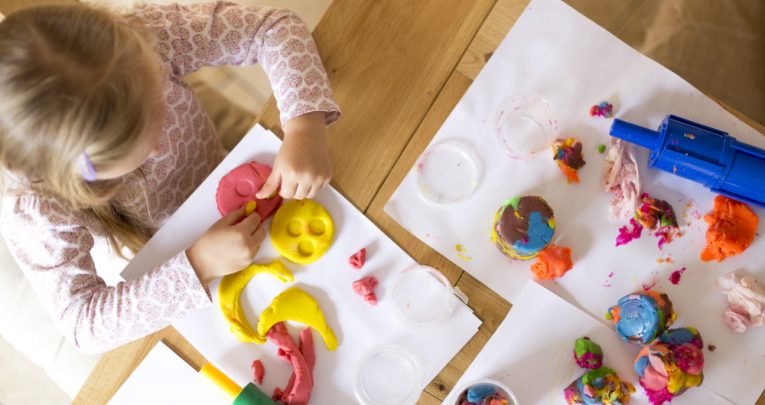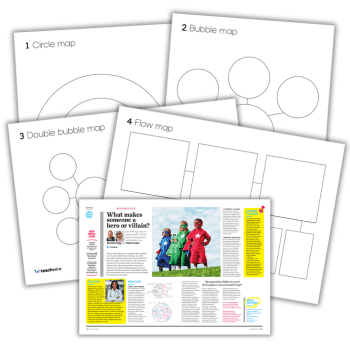Playdough Offers Endless Opportunities For Sensory Exploration

Rolling it, pinching it, kneading it and squeezing it is just the start – there’s simply no limit to the learning potential of playdough, says Kirstine Beeley…

- by Kirstine Beeley
- Early years training consultant with 20 years of experience Visit website

Dough play is well established as a central part of good early years provision, but how often do we actually consider why we’re providing it, and the extent of the developmental opportunities it offers?
Here’s why this engaging resource is the perfect way to access learning across the board…
Physical development
The most well-documented benefit of playdough is its ability to develop fine motor skills, and in particular, strength and coordination in little hands. These are regarded as essential to early writing, but actually they’re key to most things a small child will need to do to grow in independence and confidence – including being able to fasten clothing, use utensils to eat, access creative materials and use a range of tools.
Building strength and coordination is not, however, limited to hands and fingers, and some people forget that to be able to confidently control a pencil/brush/screwdriver, a child needs to build strength in larger muscles in both the back and shoulders, as well as increasing coordination in the arms, elbows and wrists.
With this in mind we must support children to use playdough to build a variety of techniques and skills: children need to be able to squash, squeeze, roll (both on a table and between their hands), pinch, pull and twist, as well as move dough from one hand to another.
Even how we offer access to playdough is steeped in the physical development process. To build those important back, shoulder and arm muscles, children need to work ‘over’ the playdough, to push down onto tables. This just doesn’t happen if they’re sitting, so playdough should be offered on low-level tables where standing is required (remember as adults we’re always role modelling, and an adult on a chair says ‘come find your own chairs’!).
Growing independence
How we offer access to playdough can have a positive impact on children’s independence and confidence. Provide it in such a way that children are able to select it themselves rather than it always being laid out, and they will develop their ability to make independent choices and their confidence to follow their own ideas.
A self-service playdough bar can be as simple as a bookcase or table with a range of exciting tools and materials alongside an airtight box. Letting children have the choice over whether or not they access the resource builds their sense of inclusion in a shared learning environment. With older or more able children, the possibility of open access to the materials to make their own no-cook playdough takes independent choice to another level.
Sensory stimulation
In early years children develop a framework for their lifelong learning, and in accessing resources and experiences with all of their senses, they build new brain connections essential to this process. Playdough offers endless opportunities for sensory exploration, and with some thought and imagination it can actively stimulate the senses as part of children’s play.
Add scents to the dough to provide smells that are calming (lavender and chamomile) or stimulating (citrus oils such as orange and lemon). Offer herbs and spices, either dry as part of the dough mix or fresh as a resource to chop and add to the dough as part of creative play; these new and exciting aromas will fire brain connections!
As well as smells, introducing new textures is another good way of stimulating the senses. Rice, chopped herbs, popcorn, coffee grounds, lentils, glitter or even sand all offer a chance for little hands to access new sensory experiences.
Experimenting with colour offers both excitement and additional sensory stimulation. Using food colouring gels rather than liquids yields more vibrant effects, while adding coloured glitters and sequins builds on the visual impact of your offering.
New discoveries
By providing these wide-ranging sensory experiences, we give children the chance to physically experience, as well as talk about and examine, textures and materials first-hand. They’re able to problem-solve and explore the properties of different mixes as they create and investigate.
‘Understanding the world’ is about children making sense of the world around them, not pre-planned ‘experiments’, and what better way to provide extensions to that exploration than in the safe world of dough play? Additional opportunities to build on early exploration can be provided by introducing a range of natural and man-made loose parts.
Loose parts
As with playdough itself, loose parts, such as sticks, shells, acorns, pine cones, feathers and glass beads, represent an open-ended opportunity to play and build on children’s own creativity and ideas.
With no right or wrong way to use them, play becomes more about the process of creating – of trying, changing and retrying – than about producing a recognisable reproduction of someone else’s work. The wider the range of loose parts you offer children access to, the wider their possibilities and creative choices.
Numbers, patterns, shapes
Introducing loose parts to dough play also offers lots of opportunity to explore mathematical concepts such as pattern, number and shape. Children are able to explore counting, thickness, comparison, length and size as part of their own creative process, and with sensitive adult support and scaffolding, talk about 2D and 3D shapes and other mathematical concepts as part of incidental discussion.
Maths is about looking for the learning within children’s play rather than over-planning an activity and stifling its possibilities (remember, too, that maths is about so much more than written numerals!).
Telling stories
The benefits to early literacy have been explored above, but don’t overlook the benefits to the creative storytelling process of encouraging children to be independent and creative. Being an author involves talking, building settings and characters, as well as developing scenarios and storylines, skills that can be practised in any kind of creative play. Playdough offers children the chance to build ideas and develop stories without the need for pen and paper.
Express yourself
Probably the most obvious benefit of dough play, and yet one of the most overlooked, is its potential to offer children the chance to explore and develop their own designs and ideas. They are able to work both independently and cooperatively to problem solve as they add varied materials to their creations and edit and re-edit their thinking. Playdough offers the chance for children to express their individuality. So next time you offer playdough (or are asked to make some), remember to take full advantage of the learning opportunities – and watch your children benefit.
FRESH IDEAS
Seven ways to invigorate your playdough provision…
- Create different doughs for additional sensory and physical experiences: try sand dough, cloud dough and even marshmallow dough.
- Add the contents of fruit teabags to your playdough for additional textures and amazing smells.
- For younger children, use edible playdough recipes – try gluten-free recipes if intolerances are an issue.
- Use plastic cereal dispensers to give children access to measured ingredients for making their own dough.
- Adding a teaspoon of glycerine creates the rubbery texture of traditional playdough, and helps to stop it drying out as quickly.
- A spoonful of vanilla essence gives playdough that familiar, shop-bought smell.
- Create “chocolate playdough” by adding cocoa powder – with empty chocolate box moulds and loose parts, the chocolate design possibilities are endless!
Kirstine Beeley is an author and educational consultant.







